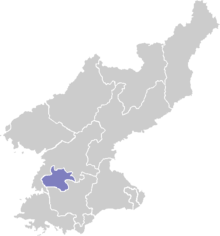P'yŏngch'ŏn-guyŏk (Pyongchon District) is one of the 19 guyŏk (political districts or wards) of Pyongyang, North Korea. It is bordered by the Taedong River in the South and the Potong River in the north and west, and to the east by Chung-guyok, from which it is separated by the railway. It was established as a guyŏk in October 1960 by the Pyongyang City People's Committee through a mandate of the Central Committee of the Workers' Party of Korea. It is probably best known as the location of the P'yongchon Thermal Power Station, which is the electricity source for Pyongyang's central neighborhoods. It is also the location of the Mansudae Art Studio and School, the Pyongyang Jang Chol Gu University of Commerce, the Pyongyang University of the Printing Industrial Arts and the Korea Okryu Combination Corporation. For international visitors, it is the location of the Pothong Hotel and the Ansan Chodasso Guest House.
Administrative divisions
Pyongchon-guyok is divided into eleven administrative districts known as dong. The largest neighborhoods (Ansan, Puksong, Haeun, Ryukkyo, Pyongchon, and Saemaul) are further divided into two parts for administrative purposes.[1]
Sources
- ↑ http://nk.joins.com/map/i003.htm
Coordinates: 39°00′00″N 125°43′12″E / 39.00000°N 125.72000°E / 39.00000; 125.72000

